Launching the Latin Daily Missal
by Fionnchu
|
Once you find a Sunday, or if you’re seven times luckier, a daily home
at a church offering the Holy Sacrifice according to the Ordus Veto/
”Tridentine”/ Mass of St. Gregory the Great/ 1962 Roman Missal/ Mass of
”Pope John XXIII”/ Extraordinary Form/ Traditional Latin Mass (TLM),
you may want to purchase a sacramental, a holy object to deepen your
“active participation” as you assist the Sacrifice of the Mass. As you
can see by those various monikers the service itself goes by,
complications may likewise follow as to in which “hand missal” to
invest. This compact compendium of the prayers common to every service
as well as those differentiating each day’s commemoration will be what
you’d bring to take you through any Mass. Not to be confused with the
priest’s “Roman Missal” used on his altar, which is heftier, more
formidable for us as laity, and entirely in Latin. For starters,
absolute beginners, and even some experienced on the TLM road, rely
upon what’s nicknamed “the red booklet,” which for us will be as if
training wheels.”
That will customarily be available for use in the sanctuary only,
gratis, stacked up in the vestibule as you enter, with a weekly
supplement sheet showing the particular readings for that Sunday (or
perhaps feast or holy day). You can print out or assemble your own
version, too, at Extraordinaryform.org.
This fine site provides templates for various alternative rites, large
print Sunday editions, cardboard handbook covers, and some Spanish
versions. By the way, at my nearly all Spanish-speaking FSSP chapel
there’s also a white-covered Latin-Espaņol booklet.
Sites such as the above provide further assistance. Under its
Catechesis side bar, you can find the TLM text, a soundtrack of what
the prayers which you will say “should sound like in Latin,” and a
brief pdf explanation of ten obvious differences “likely to be observed
by someone new” to the TLM vs. the “Mass of Paul VI (Ordinary Form).”
As well as pdf’s of presentations for high school students preparing
them for a TLM and then following up with a history of the Mass.
Your post-Vatican II parish calendar will not indicate the older
liturgical cycle. You’ll need to look up the TLM schedule (on a site as
that above or for a Latin Mass parish) and figure out, say, if it’s the
23rd Sunday after Pentecost, rather than, the “Ordinary Form” of the
Mass celebrated the 33rd Sunday in Ordinary Time. One of the delights
of the TLM is following a pattern of our ancestors, when Septuagesima,
Sexagesima, Laetare Sunday, Ember Days, and hallowed markers of the
seasons continue to color our vivid Catholic chronicle, not a stark
“ordinary” time.
On sites such as Propria.org, you
can see what “Feria” or service may occur during each week, a saint’s
day, a commemoration, or maybe a requiem Mass, a nuptial marriage, or a
local feast.
Furthermore, you can look up or print out the Propers. These prayers
vary each day. You may not find weekdays listed online; that’s another
reason to opt for a “hand missal” if you plan to attend more than
Sundays, or if you wish to make a “spiritual Communion” at home or on
the road by reading the service yourself if you cannot attend Mass in
person. The Propers tally 12.
Any missal clearly shows you where each of the Propers requires you to
turn to that section. Flipping back and forth may seem annoying, but
this rhythm for the most part will become second nature after a few
Masses. Certain missals vary slightly in how they insert the variations
of the sacrificial theme, so more about that elsewhere. For now, let’s
glance at the dozen texts.
The Introit from the Psalms naturally “introduces” the Mass, near its
beginning. The Collect follows not long after the Kyrie in the Canon,
and this leads into the Lesson from the Old Testament, a Gradual from
the Psalms, usually an Alleluia (or in Lent, a Tract), and a Gospel
passage for which you will stand. This is proclaimed first in Latin,
then in English (and/or another vernacular language if appropriate).
After the priest’s sermon, the Offertory from a Psalm follows. The next
Proper prayer you may not hear, for it’s a Secret. This signals the
heart of the Eucharistic Sacrifice is near, as the preliminary Mass of
the Catechumens concludes.
Not all the Propers may be audible. At any Latin Mass, the priest
conventionally recites to himself, or at a chanted “bells and smells”
choral High Mass within earshot of the deacon or acolyte servers, but
in a larger sanctuary, do not depend upon any amplification beyond
natural acoustics. A Low Mass generates silence; a High Mass feature
hymns accompanying “bells and smells.” This rise and fall of the
celebrant’s voice, in either form, conveys the Mystery of It all.
A Preface according to, conventionally, the Most Holy Trinity many
Sundays will happen during this stage of the service. Other Prefaces
usually are included in an extended section tucked into the Canon
itself in many missals. However, they may also be gathered into their
own chapter.
The Communion Proper from the Gospels precedes the distribution of the
Eucharist. Soon after, the Post-communion logically anticipates the
dismissal of the Mass and the standard prayers after the Mass, which
will appear in the missal after the Canon itself ends. These aren’t
Propers.
This variety will require you to mark the place where these Propers
gather, apart from the Canon of the Mass which is standard for every
Low or High Latin Mass. Doing this for the next week or weekday after
Mass each time you attend enables you to come to the next service ready
to roll. You benefit by looking ahead to the next set of readings, to
prepare spiritually and mentally for the upcoming service. Adopt a
habit of updating your missal “settings” in advance, so when the
Asperges at a High Mass or the Canon of a Low Mass begins, it’s all
systems go.
That’s the basic game plan for the Mass. You can see the scorecard at a
Fish Eaters entry for Using and Buying a Missal,
a handy roster. Holy Week’s a whole other ball
of blessed beeswax.
You may ask: why not get along with simply a “red booklet” and save my
dough? I waited a while before investing in my two missals. I was
unsure that the archdiocesan parish I attended High Mass at on Sunday
would continue once the visiting priest ended his tenure. So I put off
buying any costly tomes. There’s precious few TLMs around where I live,
and they have been decreasing rather than increasing. Providence
ensured that not only did that nearby(-ish) Mass continue with a new
celebrant, but that a Low Mass popped up at a “new” Fraternity of St.
Peter chapel a bit more nearby(-ish). That convinced me I’d be safe in
saving up for a “sacramental.”
There’s a benefit to breaking in your own copy. I keep a 1914
“Douai-Rheims” translation of the Bible handed down to me from my
grandmother who I never knew. Leather-bound, gilded pages, and imbued
with the sensation of fingers having turned its thin pages over
decades. I do not open it every day, sure. But it’s what I will pass on
to my children in turn, and they will hold on to that, I aver, rather
than my go-to “modern” translations for study and reflection. Think of
this inheritance that you may bestow within the sturdy cover and
slightly dog-eared paper that adds up to your own Latin Daily Missal
which accompanies your holy passage through this life.
What else does a
“hand missal” hold?
Here’s how the four leading editions compare and contrast. I own
neither the Baronius 1962 nor the Fr. Lasance 1945 version, so I’ve
incorporated material from online to illustrate their features. (Fraternity
Publications as an apostolate of the FSSP, kindly lent me their
samples for some photos.) I’ll integrate their differences and
similarities alongside two volumes I have and hold dear, a secondhand
St Andrew's 1945 and the reissued Angelus Press 1962 daily missal.
Now, Fish Eaters relies upon a 1962 TLM as its gold standard. So let’s
begin with Angelus Press and Baronius Press. Their missals are nearly
identical in contents. But before we go on, a note on yet another
varietal. Both missals adapt the text of a 1958 New Marian Missal of
Fr. Sylvester Juergens, S.M. In 2017 this was reprinted by Loreto
Publications. It’s considerably less expensive than the other two
missals which borrow its setup. It’s advertised at 4” x 6.5”. How
durable it is, how crisp the reproduction of the original pages is, or
how the fonts look, I cannot say. With neither a copy nor access to a
photo of its contents, for me, it’s caveat emptor.
My Angelus nearly matches the advertised dimensions for the “Roman
Catholic Daily Missal 1962” (so labeled on its cover and title page) of
6.75 x 4.25”. Yet, buyer beware again. My copy measured at the cover
rather than the pages inside adds up to 7.125” x 4.5 x 1.5. Admittedly,
the difference remains minor. But if you want to protect this with a
“bible cover” that small fraction will mean you cannot fit this into a
smaller product, and this matters. It’s difficult to find a snug fit.
As for heft, its Amazon entry reports it at 1.2 lbs. although I am not
sure if this includes the shipping material. It does require more
“handling” to keep it firm in your grip, given its bulk.
It took me a surprisingly long time to find a zippered cover (I cannot
afford the custom-fitted leather bespoke designs but maybe you can, as
they support apparently good ladies’ apostolates) that could handle the
Angelus at its irregular larger size, just enough not to fit into a
more common missal size that my Christian Prayer one-volume breviary
sidles into to “just right.” This may be irrelevant. But for those on a
budget, these details might influence choice.
Anyhow, size matters. The Angelus may be bigger than can be cradled in
one’s hand, and as I mentioned, it’s larger than the standard breviary.
I had to settle for the imitation leather plastic cover, but the
Fraternity Publications site at this writing notes the bonded leather
upgrade’s back as a limited edition. Either way, I’d ferry any hand
missal into a dry-dock haven. As Taylor Marshall’s November 2018 video
about picking one demonstrates, holy water sprinkled at the start of a
High Mass or God’s own little rain drops can ruin the gilding and soak
delicate pages.
I find the size slightly awkward as the book slides about in a case a
bit too large due to its dimensions being off the standard just enough.
But it’s clearly laid out, on creamy paper that is far too tissue thin,
to accommodate its 1980 pages. My trad friend who’s a graphic designer
by profession noted that the Angelus cleanly laid out its freshly
digitized fonts compared to the Baronius he had, as an aside. The crisp
typeface is readable, although the Latin is smaller than the parallel
English. But at least it’s entirely bilingual, not always the case as
you will soon learn.
Don’t get too enamored by sample
images you may find online at certain sellers. These may be the
Canon itself, adorned with rubrics and marginal commentary on two
separate pages. This part of some missals naturally is the most
sumptuous. But you will always be burrowing into it for smaller type
with the Propers, and even smaller for daily feasts, supplemental
prayers, and the like, if less often than the Canon. This may or many
not be a deciding factor, but be careful.
Like an auto, little add-on options may seal the deal. Angelus has gilt
edges, 5 ribbons, rounded corners, and an attractive end-sheet and
binding combination. And a must, sewn not glued pages. Indexed, it aims
at an American market, with additional feast days appended as needed.
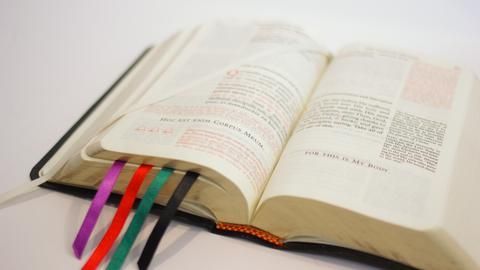
You can see its coverage here;
I will not repeat it for reasons of
space. It nearly duplicates the Baronius, with a small distinction.
This creates for some trads some debate. As Angelus Press explains its mission: “We
began as an apostolate of the Society of St. Pius X to provide
traditional Catholic literature and doctrine to Americans confused by
the changes in the Church after Second Vatican Council and the
introduction of the New Mass.” They offer free missals to priests
learning how to say the TLM as well as those who wish to assist this
mass although imprisoned. Their outreach spreads the Faith through the
SSPX, and their publications assist it.
Turning to its brotherly (I’d rather not call them competitors, as I
echo The Remnant editor Michael Matt’s call to “unite
the clans”) endeavor which attracts many trads, let’s peek at
Baronius Press. They distribute the Fraternity [as in FSSP]
Publications’ 1962
Daily Missal priced a bit less than that at Angelus. It weighs in
at 38 oz., officially 7.375” × 4.75” × 2.3125”. My hands-on
measurements include the cover (not the pages) at about 7 1/8” x 4.5” x
2 x 1/8”.
Either way, it’s bulkier than the Angelus. Baronius boasts genuine
leather and a stiffer cover. Embossed subtly with the IHS symbol.
Nigglers may quibble over relatively minor differences just like you
kick the tires and look under the hood. You can find specs at their
websites. The Baronius adds a sixth ribbon, and Pope Benedict’s
Summorum Pontificarum 2007 motu proprio. This hints that the Baronius
issues from those inching a little closer to, well, Vatican
jurisdiction.
Those old salts from the Society/SSPX vs. Fraternity/FSSP donnybrook
affirm that this latter missal comes with a forward and a 2008
imprimatur from Fabian W. Bruskewitz, Bishop of Lincoln, Nebraska. A
colophon note adds that the “text of this missal is based upon the
Daily Missal and Liturgical Manual (16th edition) published by Laverty
& Sons, Leeds, in 1960 and has been fully revised and updated.” The
Angelus edition—and I don’t mean to spark any flame war—states on its
copyright page that it is “based on The Ideal Missal” ed. by Fr.
Juergens [1962] which “bore the Nihil Obstat of Arthur J. Scanlan,
S.T.D., and the Imprimatur of C. Eykens (Antwerp).” It then credits new
commentary from what all appear as credible and approved pre-Vatican II
sources. Frankly, as the basics derive from pre-1962 sources in both
editions, in my humble opinion, it’s adds up to aesthetics or down to
which publisher you prefer.
At 2,216 pages the Baronius is thicker, although these two missals have
roughly matching height and breadth data. There’s slight variations in
supplemental prayers and certain Masses, but for consumers, as with
most car buyers, neither purchase will leave you with a lemon.
For readability, the missal by Baronius leaves less contrast between
white paper and black text. That font is darker and sharper, however.
The Angelus I concur as more elegantly laid out, but it is less easily
read in the “shade.” Both editions scanned and retouched identical
illustrations. The Latin is smaller than in the Angelus. Marginal
comments are absent within the Canon for the Baronius. But there’s
compensation with much larger type for that quintessential portion.
You can click here
to browse through a few pages. And here
to see “digitally retouched” images of the engravings from the Fr.
Juergen Belgian originals. Overall, the contents and design of the two
missals totals up to a reliably similar delivery of supplemental
materials. Their page difference may come down to margins, or, as the Baronius
Press site illustrates, font legibility.
As Corpus Christi gets a lot more “press” within the various missals
over the past century, British Benedictine Fr. Hugo at his blog
provides commentary and photos of the respective layouts for this day.
You can contrast and compare many more missals than the 1962 pair, or
Fr. Lasance and the St. Andrew. The typefaces and engravings allow you
to chart the liturgical changes before and after Vatican II, and his
entry chronicles the rise and ebb of the TLM itself.
Let’s move on to those two earlier missals. While Fish Eaters
“approves” the 1962 editions, as these are standard for either a
Fraternity/ Institute of Christ the King/ diocesan-sponsored service or
the Society’s at their own chapels, both the St. Andrew’s and Fr.
Lasance predecessors find favor among many TLM participants. As vintage
models, they display their own charm. (Likewise Lisa Bergman’s lavishly
laid out “menu” Treasure
and Tradition. This handsomely illustrated and intelligently
designed survey will delight all children and inspire any adult. This
would be an ideal companion to catechize newcomers, and its rich
graphics enhance the diagrams, explanations, and definitions of all
portions of a TLM. This combines the aesthetics of a classic,
pre-conciliar sensibility with up-to-date interpretations. (Sample
Isuuu slides at the link above; this guide is available at bulk pricing
and would grace a parish group rallying for a TLM. Thanks to St. Augustine Academy
Press for their shared offering of this elegant introduction.)
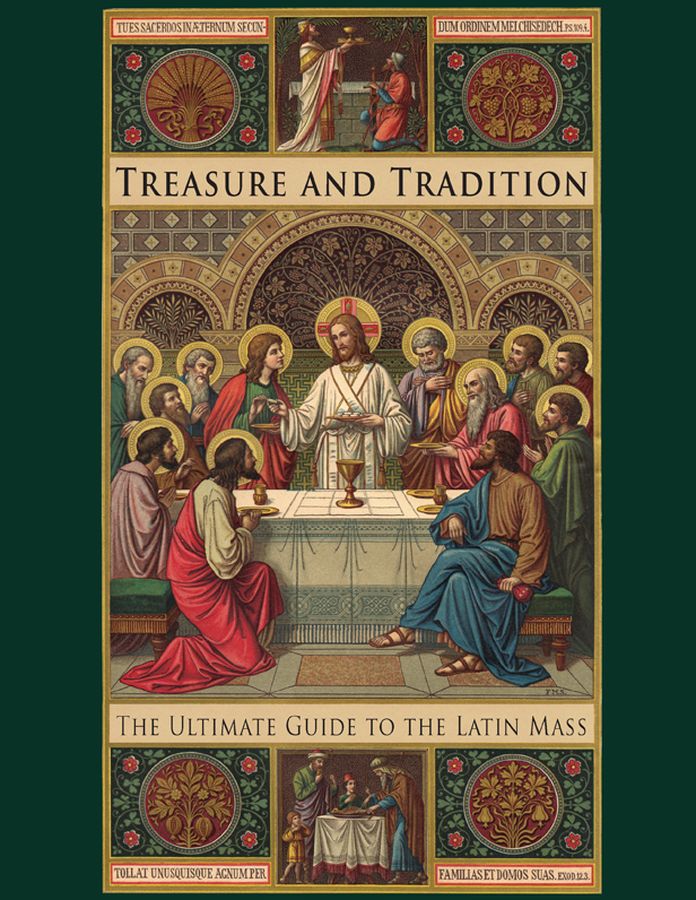
Treasure and Tradition matches the elegiac mood of St. Andrew’s Daily
Missal (SADM). That represents the Liturgical Movement which from
around post-WWI jump-started the Low Countries and Germany’s
fine-tuning and tinkering which would spark the changes that kick in
after WWII, and cut deep into the Vatican II sessions and their 1962
modifications of the TLM.
Coming out of Belgium, the Benedictine Abbey of St. Andre, under the
diligent editorship of Dom Gaspar Lefebvre (no relation to Abp.
Marcel), labored over a few iterations of this SADM. So, purchasers of
used copies need to exercise caution. My copy records its original
Imprimatur of 1940, and for the English edition, another by Cardinal
Spellman from 1943, with copyright dates of 1940, 1943, and 1945, as
well as a brief blurb from one Arthur, Archbishop of Westminster
[London] dated 1937 praising its “re-issue.” You get my point: WWII
dates for once add up as good things; although due to wartime
restrictions—Belgians had their own worries—the missal’s English second
print run had to be done in Quebec and/or by Lohmann in St. Paul.
This may sound like bibliophile trivia. But, trust me, I had to hunt
for the SADM I wanted second-hand carefully for the right one. And I
still got it half-wrong. A more commonly peddled secondhand 1958 update
portends the Council as the formerly somber artwork goes from
engravings similar to those of the Fr. Juergens template to less
intricate, more generic, and mid-century symbolic drawings, and the
amount of Latin diminishes. As a relevant aside, while the handsome St.
Andrew’s Bible Missal has admirable commentary on the Sunday readings,
it serves more as a time-capsule of the hopes during the Vatican
Council to encourage lay understanding than a book one can use for its
fast-changing 1960s versions. Be sure not to confuse the Daily Latin
with the Vatican II editions of the Bible Missal. What surprised me:
even in my 1945 copy, there’s no Latin for the Collect, Epistle,
Gospel, Secret, Postcommunion or many Holy Week passages. Evidently,
the vernacular’s already dominating portions of the TLM, or the monks
figured most people did not mind the loss of a bilingual text for
Propers and such.
Note well: I see images below of the SADM—that look just like mine on
the outside—on the inside contain bilingual pages throughout, at least
as the Sunday Mass is concerned. With entire, larger engravings,
whereas my “Regular Edition” (c) 1945 has them severely cropped. It
appears that my copy cut out a lot of this scriptural commentary, to a
perfunctory weekly snip.
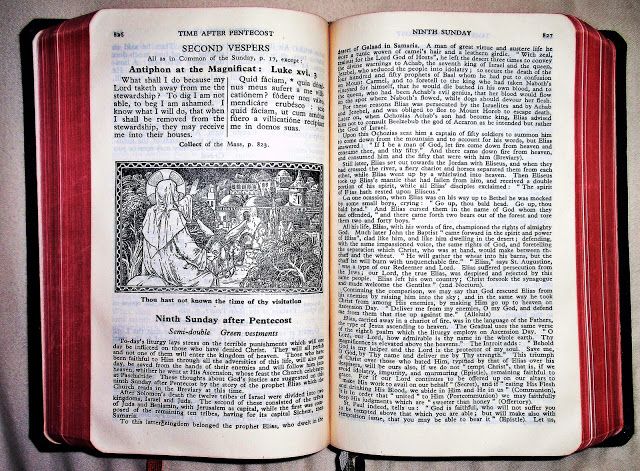
Keep this in mind. For many, doubtless this will not be a deal-breaker.
But if like me you like to follow the Latin as much as possible, the
SADM’s choice to jettison some of it—at least in my edition—to keep its
size compact and the “feel” of the volume, which fits my big palm
neatly, means sacrifices were made. Perhaps, come to think of it, due
to WWII and paper restrictions?
My secondhand copy has a sturdy and “lived in” leather cover. Real-life
dimensions taking into account its binding add up to 6.5” by a smidgen
over 4” and 1” thick. St.
Bonaventure’s Press in Montana publishes a conventional cloth-bound
one, with gilt or red-tinged pages. Looks like it delivers the entire
Latin-English text and “full monty” presentation of art. For its
pagination exceeds mine by about 700 pages. And, it lines up at 6.75” x
4.25” x 1.75”. While it claims that no changes have been made, an
online commentator (on a 2017 YouTube video survey of darn near every
hand missal, collected by Paul Flores Photography) asserts that the
reprinting takes out the rubrics that direct lay congregational
response in the Dialogue Mass, which was an early alteration that the
Liturgical Movement got approved decades before Vatican II. These
rubrics, in any case, tutor any reader well in comprehending these
intricate rituals and their rationales.
I inserted three illustrations of a complete SADM as the publisher does
not offer more than the last image. While online browsers of the
Baronius and Angelus Press versions can find bloggers and vloggers
taking you through their features, the SADM comes, at least for
contemporary inquirers, in fewer online representations. It also
survives, by the way, in a four-volume boxed set after WWII. Copies of
this, some in part, less as the whole, and fewer still in terms of
quality and intact bindings, can be procured from secondhand
booksellers and on E-Bay. The prices tend to be exorbitant (and this
goes for other missals too) and care must be given for ensuring sellers
“comprehend” what “Vintage Old Latin Missal” they are hawking. I scored
at a bargain a supposed SADM in the current reprint as assured at
E-Bay. Only to find it was Fr. James Socius’ Novus Ordo 1970 Latin Mass
of Paul VI. Handsome. I wish it was what I had wanted. I explained this
flaw when claiming reasons for a return and a refund. One advantage of
E-Bay.
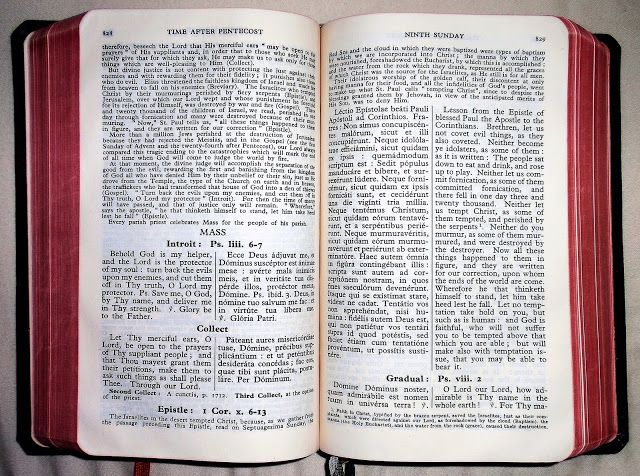
You can see a complete SADM in these samples. (Having conducted this
drive-through run, I cannot ascertain precisely when I presume an
“original style” luxury model rolled out to the market instead of my
1945 war-privation compact “jeep.”) Over 1900 pages reprinted, five
ribbons, but far less introductory orientation than other missals. It
lacks the personal prayers and devotions, and its index is pretty much
geared towards finding saint’s days, feasts, and Sundays, with no table
of contents. The font shrinks throughout, and its footnotes for all
their erudition may be nearly indiscernible for those needing a boost
in lighting, vision, or clarity. Still, the balance of commentary for
the celebrations throughout the seasonal and Sunday cycles, the beauty
of the layout and the illustrations, and the dignified tone throughout
may win you over.
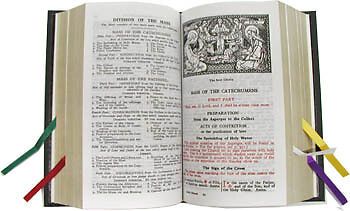
On to the last one, judged in that 2018 Taylor Marshall video as the
winner against the Angelus runner-up. This popularity meant that it’s
been selling out, and reprintings may be hard to find. Attesting to
today’s presence of TLM devotees seeking out a missal that will last
for decades.
First of all, you can see what you’re getting, at least as far as the
engine if not the exterior. Archive.org
uploaded from a trad website (which watermarked each page with its URL)
a “Latin Catholic Roman Missal 1938 Mass.” Which means if you search at
Internet Archive under variations of “Fr. Lasance” you will not find it
there. The pdf is ragged, as if the pages were torn out, and sizes of
some vary in resolution or dimensions, but at least you can manipulate
the images to read its wavering font reproduction, more or less. And,
the Latin and English are equal in size, the only instance (outside the
space afforded in many missals for the Canon) of a missal consistently
typeset. Here is the opening before High Mass commences, for
comparison.
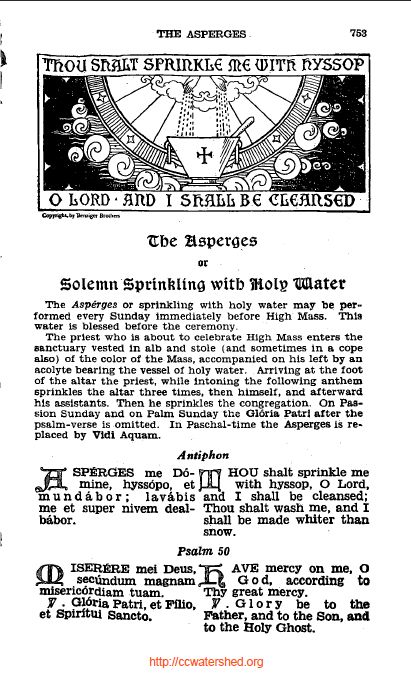
In the printed missal, see how the rubrics reproduce the commentary for
the Canon as rubrics.
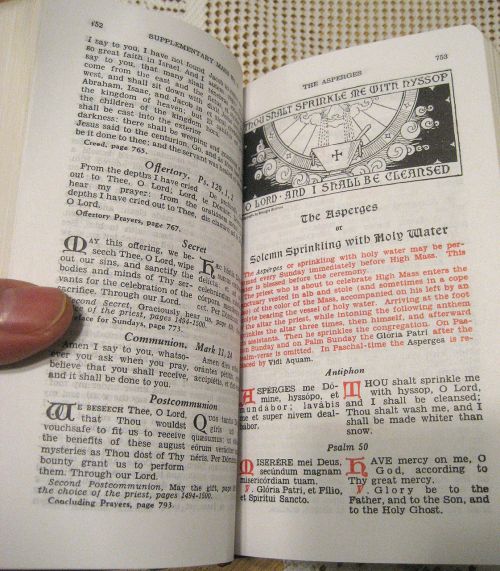
Two features distinguish the “Fr. Lasance New Roman Missal.”
First, the illustrations of the Canon. The Daughters
of Mary Press gives viewers a two-minute video glimpse, even if a
lot of that time is not given over to the actual details on the page.
The Lasance 1938’s table of contents and index of Masses and
Prayers—and a sample engraving page from the Canon— is scanned better
at Fish Eaters’ Using and Buying a Missal.
Quality, if in motion, images of the contents, will best be seen in Dr.
Marshall’s “Latin Mass Hand Missal Review.” (Given our FE
editrix-dudette-founder’s counsel, amidst uncertainty of YouTube and
online platforms long-term hosting TLM alongside conservative or
traditional media, I have not embedded YT links; sustained stability of
these redoubts may succumb to a N.O.~N.W.O.)
Therefore, I direct you to sage advice at St.
Anne’s Helper about choosing the right missal, and as that site
frames the YT Marshall plan. (They also sell custom-fit missal covers
for the Big 4.)
Their explanation at the link above mentions that the Lasance includes
English and Latin texts, with the exception of Epistles and Gospel
readings in the vernacular only. Like other missals, it highlights
rubrics for Mass directions, and it includes material “stressing the
important Feasts and Highlights of our Redemption.” Litanies,
devotions, rosary mysteries, prayers, hymns, saint’s days, psalms
enrich its 1900 pages, with imprimaturs from 1936 (that version you’ll
peer at via Archive.org) and 1945. This would mean, as for the SADM,
that minor changes in pre-1955 Holy Week, a few feasts, holy days, or
solemnities, and/or the Canon may occur, but rarely. Standout
additions: an in-depth “Read Mass with the Priest” illustrated study
plan on how the mass and the missal work together that begins the
volume, very comprehensive coverage of the “symbolic representations”
as well as the hallowed sacramentals of the Eucharistic Sacrifice, and
lovely line-engravings of key moments in the Mass. That plan will take
you through Lent, too. I have not dealt with this complicated aspect,
which has at least one vlogger on You Tube attempting to explain it all
in the length of a sit-com. Suffice to say, you all can dial up a pdf
of the Lasance on Archive.org to learn from those experts. These
bonuses won over Dr. Marshall.
It rounds out on the larger end of the scale: 6.75” by 4.25 by the
thickest yet, dimensions of 2.25”. In my hands, cover and all, this
tallies in real life nearly 7” x 4/14” by 2 1/4”. It bends and gives
when held much more flexibly than the Baronius, and somewhat more than
the Angelus. The Baronius and the Fr. Lasance are about the same in
heft, and page thickness nearly identical, with a slight increase in
the latter of around an eighth of an inch. The paper of each skims
across the fingers with a slight gloss, and the consistency of both
feels the same to me.
Here you can see, at the Consecration, how the Fr. Lasance on the top
contrasts with Baronius.
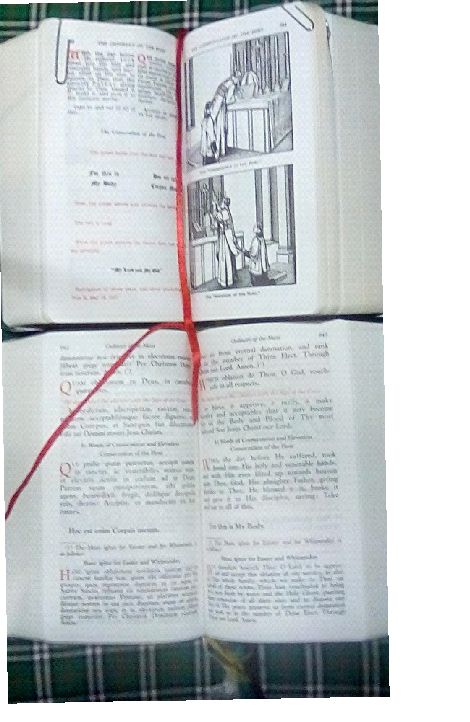
The Lasance tends to tip up a bit, as the paper is thicker for the
Canon. I wish all the missals had this clever innovation, for after
all, it’s the part of any missal where we turn every Mass. I found that
the black type on paper stock not much different side-by-side with the
Baronius. Like the St. Andrew’s, these all prefer a slightly sharper
definition of the font, but not as “elegant” as the Angelus. Pay
attention to this consideration; you’ll be peering into these pages for
awhile.
Remember, if you buy a reprint of the St. Andrew’s, that comes in a
conventional clothbound form. The Fr. Lasance’s black leatherette
cover, gilt, rounded edges, and sewn binding ensure durability. Not to
mention a sixth ribbon, justified as there’s a lot packed into this
missal, as a vademecum. Keep in mind, all the same, that the
compressed, old-school typeface is smaller.
Scourers of secondhand shops may benefit from knowing that
post-conciliar editions may have on their title page “Christian Book
Club of America” established as a post office box set in the unexpected
(speaking as a Californian) high desert exurb of Palmdale CA 93560,
dated 1993.
Here’s my amateur snap at showing all four missals with an eight-inch
clear and a foot-long wooden ruler. At top left, Lasance, then next to
it, Baronius. Below, Angelus and Andrew as the reprint. They tend to
look nearly the same when looking down at their covers, note well. It’s
on the side where the differences show, as they vary considerably in
pagination and thickness. All feature similar leather-types of
bindings, that are slightly textured to stick to one’s digits gently.
Here’s my amateur snap at showing all four missals with an eight-inch
clear and a foot-long wooden ruler. At top left, Lasance, then next to
it, Baronius. Below, Angelus and Andrew as the reprint. They tend to
look nearly the same when looking down at their covers, note well. It’s
on the side where the differences show, as they vary considerably in
pagination and thickness. All feature similar leather-types of
bindings, that are slightly textured to stick to one’s digits gently.
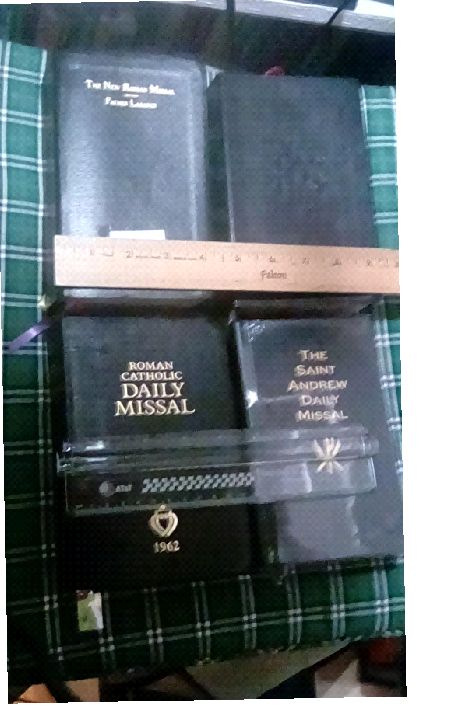
It pays to educate yourself about the heritage creating all these
surprises or serendipities. As Martin Mosebach narrates in his erudite
essays as The Heresy of Formlessness, for centuries, the Roman Missal’s
bulk required at least 850 pages were required to contain its contents.
And our humbler hand missals perpetuate this venerable arrangement.
Introductory remarks, perhaps an encyclical or two, then Advent,
Christmastide, Time after Epiphany, Season of Septuagesima precede Lent
and Passiontide. Paschaltide follows Easter, then the long
post-Pentecostal year (reduced post-Vatican II to “Ordinary
Time).” The Canon of the Mass falls around the halfway point of
any pages. Then it’s feasts of God and Christ, Mary, and the feast days
of the saints. Similar to a breviary, various Masses are compiled for
liturgical categories. Devotions may be interspersed, although the
pattern of Fr. Lasance to put these last makes sense for the user in
the pews. However you package it, the results remind us of timeless
ritual.
What about smartphones? The silent gentleman that has lately suddenly
taken up his post in the pew next to where I “always” sit (such
idiosyncracies in proxemics expressing our need for childlike security
remain legion among many of us once we settle into where we habitually
fulfill our Sunday obligation) follows along in night mode on his
I-Phone the TLM. I-Pieta, I-Breviary, and the multilingual Divinum Officium have sites or
apps that contain all you need.
But, I prefer the wisdom of Robert Cardinal Sarah in The Day Is Now Far
Spent (2019). As a proponent of tradition (if not it seems the TLM
explicitly in his book-long exchanges with Nicolas Diat), he counsels
us to eschew any app or device that can distract us from the business
at hand. And, going back to my initial praise of sacramentals, I agree.
The “hand missal” you take the time to pick out, break in, and take for
weekly or daily spins will get to be yours, as much as the car whose
noises, rattles, bumps, glides, and turns you learn to integrate into
your routine as second nature. For some of us, the older the jalopy,
the more we love its odd idiosyncracies.
And, for all our dependence on the technology and medium through which
you and I share the wonderful FishEaters forum and its library, it’s
refreshing to find an oasis from always logging on. So, I close this
overview with my encouragement to choose with care your favorite model
of the missal. You’ll be happier if you take them for test runs, as far
as online images and textual advice can offer, and ideally (not my
option, thus this project for me) handling their pages “live.”
As to the liturgical lore within the covers of these compendia, ponder
Bishop Athanasius Schneider in his profound chapter on “Reform of the
Reform” from his 2019 interviews with Diane Montagna, Christus Vincit:
“In one’s private prayer, everyone speaks with God in his mother
tongue, but when we speak in public worship and the cult of God, we
speak publicly about the truth of God, who is an ineffable mystery—a
mystery which is fascinating but cannot be expressed, an awesome and
fascinating mystery: mysterium tremendum et fascinosum.”
With blessings on your journey with these missals on the pilgrimage we
all share, “Fionnchu.”
|
|
 Back to Being Catholic Back to Being Catholic
 Index Index
|

